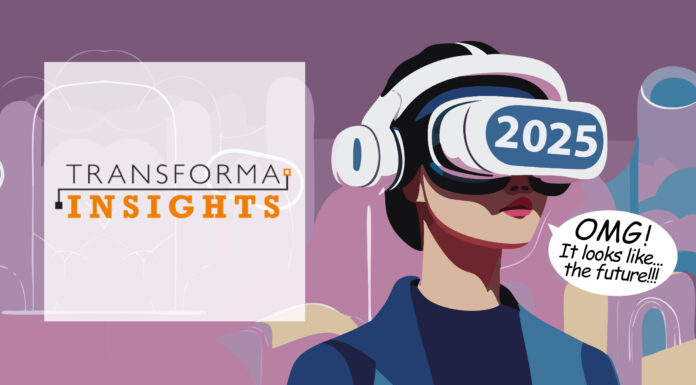IoT continues to be a dynamic and evolving field, with 2025 set to bring key transitions in technology, market dynamics, and regulatory frameworks. Transforma Insights has outlined ten critical themes, or ‘Transition Topics’, expected to shape the IoT landscape in 2025, and set to form the backbone of its 2025 research agenda. These topics encompass AI integration, connectivity, regulations, geopolitics, and verticalisation, each holding significant implications for IoT adopters and vendors. In this article we briefly explore these pivotal trends.
1 | Integrating AI into IoT

It is a truth universally acknowledged that any set of technology predictions for 2025 has to lead with AI. And the reasons are clear: it has justifiably come to dominate all technology discussions. IoT is no different. Specifically, the most critical consideration for IoT is the way in which AI will be implemented on board IoT devices. Or ‘AIoT’. Embedding AI directly onto IoT devices enhances functionality, enabling real-time decision-making and sophisticated data processing. In 2025, the market is expected to witness accelerated adoption of AIoT, reshaping product development, architecture, and market strategies. Transforma Insights plans to explore the market opportunities and the transformative potential of AI in IoT. We already started in 2024, with a report quantifying the opportunity: ‘Global AIoT Forecast, 2023-2033’.
2 | Managing distributed AI
Not only does AI account for our first Transition Topic, another aspect of it also accounts for our second. As AI applications proliferate, the orchestration of AI workloads across edge devices, campus edge, network edge, and cloud environments (and a few other locations in between, doubtless) becomes paramount. Efficiently managing these distributed systems will require new capabilities in compute, storage, and software updates. In 2025, organisations will face the challenge of ensuring seamless integration and orchestration of AI solutions across various layers of networks, an area ripe for technological innovation and analysis.
3 | New eSIM orchestration
Of all the themes in IoT, connectivity is probably the closest to Transforma Insights’ heart. And it promises to be quite a transformational year. The arrival of the upcoming SGP.32 IoT standard for remote SIM provisioning is set to redefine IoT connectivity. Or, at least, some of it. In 2025, eSIM orchestration will emerge as a distinct role, separate from traditional network operators and resellers. We expect this to particularly suit some IoT MVNOs for whom the platform function was always the key role, for instance 1oT, Eseye, Simplex, Soracom, and Teal. This shift is further amplified by the increasingly significant regulatory demands necessitating more localisation of connectivity, and the ongoing shift in the Connectivity Management Platform landscape to incorporate more single-pane-of-glass (SPOG) abstraction platforms. We saw a few movements in this direction in 2024 but we expect further evolution in 2025.
4 | Monetising 5G for IoT
With 5G Standalone (SA) networks gradually gaining traction, mobile network operators (MNOs) will focus a lot of attention on seeking ways to monetise their investments. IoT potentially presents an attractive avenue, leveraging 5G SA features including ultra-low latency, network slicing, and advanced APIs. Transforma Insights will shortly publish a report highlighting the ways in which MNOs can generate new connectivity revenue from the additional functionality delivered by 5G (and particularly 5G SA). Spoiler warning: the vast majority of 5G revenue will comes from services that could be delivered via LTE, with the specialist 5G SA functionality really only set to generate a modest amount of revenue. But we’re a long way from seeing real-world adoption and our cynical views on likely appeal of Quality on Demand, network slices and APIs could well prove wrong.
5 | Decisions on LPWAN
While we’re on the subject of networks, one of the major drivers of 5G adoption is likely to be a 4G/NB-IoT/LoRaWAN-shaped hole in the network landscape. As 5G adoption grows, decisions regarding legacy networks like LTE and NB-IoT will become increasingly pressing. We have all see the much-discussed dropping of NB-IoT by AT&T. Rumours also swirl about faster-than-expected sunsetting of LTE, at least in the US, whereas Europe will take a decade or two longer. Similarly, the fate of public LoRaWAN networks hangs in the balance. In 2025, many operators may prioritise 5G while reassessing their commitment to older technologies, shaping the future of IoT connectivity and signalling a potential shift towards consolidating networks.
6 | Satellite IoT disruption
The proliferation of Low Earth Orbit (LEO) satellites and the arrival of Non-Terrestrial Network (NTN) technology means that satellite will continue to be a focus in 2025.The industry will evaluate whether satellite IoT will complement or compete with terrestrial networks and explore strategies for operators to adapt to this new paradigm.
7 | Regulation of IoT
Compliance with evolving regulations, such as the EU’s Data Act and Cyber Resilience Act, will remain a top priority in 2025. From security to permanent roaming, to data sovereignty, IoT adopters will need to navigate complex legal landscapes. Similarly there will be increasing attention paid to how vendors are architecting their offerings in order to ensure they are also compliant. Transforma Insights has built a Regulatory Database to keep track of the many and various regulations.
8 | Geopolitical dynamics
The next twelve months will see greater manifestations of geopolitical tensions and consequent market polarisation. Regulations like the EU NIS2 Directive and the UK Procurement Act, as well as an increasingly unwelcoming environment for Chinese vendors in the US, will trigger quite significant changes in the approaches to supply chains, vendor selection, and software standards in 2025.
9 | Verticalisation in IoT
IoT is always vertical. In fact arguably there is no such thing as IoT, just a series of vertical applications which might share some common underlying technologies lumped under a single convenient umbrella term. There is an increasing realisation in the vendor community that a one-size-fits-all approach to addressing IoT is becoming unsustainable. In 2025, capabilities tailored (or simply positioned) for the needs of specific verticals will increasingly gain in prominence.
10 | Optimising sales
Tightening margins in the IoT space necessitate more refined sales strategies. Market segmentation, channel optimisation, and robust partner programmes will be key to driving growth in 2025. By targeting the right customers and fostering strong partnerships, vendors can avoid some of the worst excesses of price erosion.
The IoT landscape in 2025 will be characterised by rapid advancements, from the proliferation of AIoT and the evolution of connectivity to regulatory challenges and verticalisation. Each of these trends presents opportunities and challenges for industry stakeholders. By focusing on these critical themes, Transforma Insights provides a roadmap for navigating the complexities of the IoT ecosystem in the coming year.

